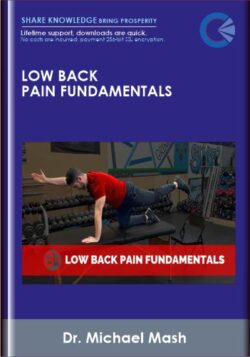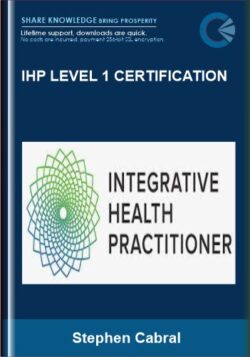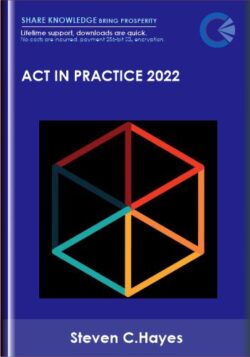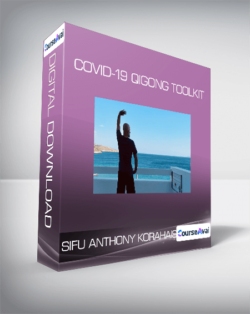ACT in practice 2022 – Steven C.HayesApply ACT with ConfidenceGain practical tools for applying ACT from Dr. Steven C. Hayes through 10 online modules featuring extensive demonstration videos, network diagramming, clinical analysis, treatment planning, reads skills practice, and more.Lifetime AccessCourse enrollment comes with lifetime access to all course materials, plus you’ll be protected by a 14-Day Money-Back Guarantee.Confidently Apply ACT from Intake through TreatmentCreate a guiding framework for effectively usingacceptance and commitment therapy to cultivate lasting changeThe Gap between Theory and PracticeIt’s one thing to know the ACT model and its principles in the abstract.It’s another to implement them in a way that’s impactful and organic, especially when you’re sitting across from a challenging client and the clock is ticking.With clients who seem disengaged and resistant to change, or cling to goals of diminishing “bad” feelings, the way forward is often unclear.In these scenarios, the theory might make perfect sense to practitioners conceptually . . .But when it comes to applying ACT, they’re less confident.Self-doubt creeps in, and they hesitate to make their next move, questioning if it’s the best one to guide the client toward meaningful progress.And unlike the masterful sessions clinicians see in workshops, many of them instead share experiences like the following:They work comfortably with acceptance and defusion, but struggle to find the right exercise to target self-as-context, so avoid it in sessionsThey sometimes feel like teachers instead of therapists, relying on lecturing to introduce concepts instead of weaving experiential exercises naturally into sessionsThey feel stuck when it comes to challenging clients, unsure of how to move forward or make their sessions as valuable as possibleThey hesitate to push certain clients to engage with difficult thoughts or feelings for fear of demotivating them further, but end up on different pages about their therapeutic aimsThey approach sessions with rigid ideas about what should happen next rather than being able to respond flexibly to the momentExperiences like these are surprisingly common among ACT practitioners.Even skilled clinicians can feel uncertain when tailoring treatments for particularly difficult clients — especially without resorting to cookie-cutter interventions.But why is this the case, when we know the model and have seen it work?The answer goes beyond simply practicing more of the same, into something at the heart of this method.How a Process-Based Framework Helps You Apply ACT More Effectively1.It helps you think flexibly instead of linearlyHuman lives are not composed of a few events laid out in a linear fashion. So despite our best efforts, approaching therapy in that way can lead to a dead end.Still, linear thinking is so ingrained in our training and culture that a flexible approach can feel abstract if it is not guided by practical tools.With the tools inside our process-based framework, we can instead see how underlying processes cause behavior to reinforce and amplify itself in loops.For example, suppose you have a client who has gradually had her life shrink due to chronic pain following an injury at work and resulting over-use of opiates. It is easy to focus on her pain and how her use of opiates has led to a growing addiction.However, the linear sequence of injury → pain → opiate use may block out other important case features, such as how the injury impacted her financial stability, or how her father’s Alzheimer’s has fed fear and fusion in her life.Network diagrams allow us to clearly visualize behavior patternsBy using this framework to gain a non-linear perspective of a client’s case, you can develop a more nuanced understanding of their behavior and make a better plan to intervene.2.It allows you to turn case complexity into opportunityWhen you’re struggling to apply ACT principles in-session, it’s difficult to know how to intervene in the moment and at the same time know that it’s tied to long-term success.A process-based framework allows you to clearly see behavior patterns within the whole context that retains them. Because of this, you will have a holistic understanding of the case and will see more opportunities to intervene if an attempt falls flat or you simply hit a wall in therapy.This framework allows us to approach therapy strategically, like a game of chessFor example, while you may identify a crucial experiential avoidance pattern and see an opening to target it with acceptance, you’ll also see options to alter that same core patterns using other processes.This framework also allows you to see strengths — instances of psychological flexibility — that you can build up as part of a holistic treatment strategy.I was recently reminded of the importance of such thinking when working with a client who found herself undermining intimacy in her relationships.By expanding the focus, I discovered a fused self-image, only noticeable at work, that she was “likely to break under pressure.” After employing self-compassion and defusion work focused on this sense of self, she was then able to work on vulnerability in relationships.In other words, this framework allows you to approach therapy like a game of chess:Instead of thinking one move at a time, you’re visualizing a way to win the whole game.3. It provides a guiding pathway for work with lasting impactRather than offering a formula or protocol, this process-based framework gives structure to therapeutic aims throughout our journeys with clients:It gives you a clearer sense of what to ask during intake to better understand a case.It allows you to map the psychological flexibility model onto case features and find the best opportunities for intervention.It helps you plan treatment based on what is most likely to work for that specific client.And even after you begin implementing that treatment strategy, it gives you a reference point to help you see when things are moving — or to make a new plan if they aren’t.This will allow you to pivot much more flexibly, and if necessary, can also help you answer the question: “What have I missed about how a certain behavior is being retained?”I had to ask myself this very question in work with a client where I’d initially failed to think through how new actions would be self-sustained.These processes will allow you to have a lasting impact in your work with clientsI saw values as an endpoint, missing that the client would need mindful attentional skills to know when to act on those values and to recognize progress in building values-based habits. By focusing more on attentional skills, the ability to sustain a positive outcome felt much more likely.These gaps are typically the hardest thing to see in a case, but with a process-based framework, we can more easily identify them and shift our approach.Once you understand how to use the tools within this framework, you’ll come to your very next session with a clearer pathway in your head and the psychological flexibility model built right into it.That way, you’ll be able to more strategically bring about lasting change.Learning this ApproachI hope you’re starting to understand how this expanded process-based framework can help you ground ACT theory in practical application so you can implement it more creatively, confidently, and effectively. Seeing this framework in action and practicing it yourself is the best way to learn how to apply it in your own sessions.And that’s exactly what I’m about to share with you.Below are all of the details about my online course that builds on what you already know about ACT, teaches you practical tools for applying it, and shows you how to put them to work in sessions. Inside, we’re going to bring the philosophical visions of process-based therapy down to things like how to do an intake, how to do a different kind of diagnosis, how to do a functional analysis, how to design a treatment, and how to face other challenges presented in your daily work.Along the way, you’ll learn practical skills and tools to help you more effectively bring about positive change for your clients.Course FormatIn this online training, you will learn about some of the most recent and important developments in all of evidence-based therapy, with an emphasis on seeing them in action so you can put them directly to use in your own practice.ACT in Practice combines video instruction and exercises with some of the most extensive footage available of an expert applying the psychological flexibility model in strategically designed roleplays and real conversations with healthcare professionals working on personal issues. In this way, the course offers both a more advanced ACT experience as well as a highly practical approach.Course content and materials are in English, and all videos will include subtitle options in English and Spanish.The example sessions were all conducted remotely, via video call. So you’ll get a chance to see how you can fully engage clients using this expanded framework, even completely online.Using tried-and-true ACT methods, such as skills exercises, alongside cutting-edge tools, you’ll learn how to gain a deeper understanding of even the most complex cases, make more accurate reads, plan targeted interventions, and apply the Hexaflex model with greater confidence and flexibility.Course StructureACT in Practice is a self-paced, entirely online course.The 10 modules will be released at a rate of one module per week so you’re able to fully absorb the material before moving on.However, you’re also welcome to work through the modules more gradually as your schedule permits. With lifetime access to all course material, you will be able to revisit it anytime in the future, including any future updates that are made to the course.The first 3 modules introduce you to a new, process-based framework that will allow you to apply ACT theory with creativity and confidence.From the very beginning, you’ll complete exercises to put this framework, and the tools within it, into practice. You’ll also watch Dr. Hayes apply it in three important stages of the client relationship: doing an intake and building a preliminary network diagram, performing a new form of process-based functional analysis, and planning and implementing treatment.In Modules 4 through 6, you’ll view roleplays with different clients covering work from all corners of the Hexaflex model and will hear Dr. Hayes explain why he made certain choices at critical moments.Module 7 will focus on how to move to any point on the Hexaflex at any moment and do effective work — even with challenging clients.In Modules 8 and 9, you’ll hone and test your skill in reading clients’ psychological flexibility, as well as in identifying the processes a therapist is targeting in session.You’ll conclude the course with Module 10 by improving your ability to discern adequate, good, and excellent ACT interventions, using Dr. Hayes’s example session for practice, which will ultimately make you more effective in your own work.In the last two modules, you’ll also benefit from the insight of Dr. Robyn Walser and Dr. Kelly Wilson, two of the world’s leading ACT experts, who collaborated with Dr. Hayes for written exercises and a point-by-point discussion of a real play. This will give you an opportunity to measure your skills more objectively while also learning from additional world-class practitioners.Throughout the course, you will develop a guiding framework and practical skills that help you:Develop a deeper understanding of your clients from the very first session, so you can plan and implement treatment more effectively with holistic aims in mindAccess a broad range of exercises, metaphors, and interventions that can help you create experiential learning in sessions rather than resorting to lecturingHone your ability to make accurate reads and identify client strengths and weaknesses as well as opportunities for meaningful workAlways have a full grasp of your client’s entire case and how issues are being retained, so you can move flexibly between processes and maintain a clear sense of directionUnderstand how to use the psychological flexibility model as a framework for incorporating other important processes and interventions in evidence-based therapyAfter completing these 10 modules, you will have the practical skills and tools to be more effective in your very next intake.CurriculumBelow is a breakdown of the main skills and tools you’ll learn within each module. Each learning unit includes video instruction, written material, footage from example sessions, and practical exercises for applying new concepts, as applicable.Module 1: Preliminary NetworkHow a process-based framework offers a better way forward than previous efforts to categorize and treat psychological disordersThe guideposts you can follow throughout the client relationship to better understand someone’s case, choose interventions, and measure outcomesStart building the practical skills needed to visualize a client’s case clearlySee Dr. Hayes’s thought process as he walks you through creating a preliminary network diagram for Mariana, a roleplay client dealing with a history of abuse and struggling to find joy and connection in lifeDraw your own preliminary network diagram based on a case study of Stan, a father experiencing debilitating anxiety that impacts his relationship with his familyModule 2: Functional AnalysisHow process-based functional analysis can help you choose treatment interventions that give you the greatest chance of successHow to measure a client’s psychological flexibility, your therapeutic alliance with them, and treatment outcomesUsing an Extended Evolutionary Meta Model to understand clients’ psychology in relation to physiological and social factorsWatch Dr. Hayes perform functional analysis of Mariana’s case by building on his preliminary network diagramTake your preliminary network diagram of Stan’s case to the next stage: creating a functional analysis diagramModule 3: Treatment PlanningTurning functional analysis into an effective treatment plan that fits with a client’s goals for therapyHow to disrupt maladaptive behavior patterns within a case and turn them into self-sustaining adaptive loops that will last even after your work with a client endsReview an emotional approach to creative hopelessness for Mariana, a strategy that can be used with clients who are resistant to changeWatch as Dr. Hayes creates a treatment plan diagram for Mariana and shares his thought processBased on your functional analysis diagram from Module 2, draw a treatment planning diagram that helps you map out impactful interventions for StanModule 4: Acceptance and DefusionIdentify reads and interventions related to emotional and cognitive flexibility (acceptance and defusion)How to target these two processes indirectly through other areas of psychological flexibility, and vice versa, opening up more options for meaningful interventionWatch a 3-part roleplay with Mariana showing key elements of the treatment plan created in Module 3Examples of how to successfully implement defusion and perspective-taking exercises, and how to repurpose pain into values-based actionModule 5: Present Moment and Self-As-ContextReview psychological flexibility reads and interventions related to touching the “now” and sense of selfHow to move these processes indirectly through other corners of the hexagon in order to expand your flexibility during sessionsView a 3-part roleplay with Sally, a client experiencing depressed mood as she flounders without a sense of purpose in retirementSee Dr. Hayes taking a psychoeducational approach to creative hopelessness within the roleplayExamples of how to successfully implement present moment exercises and the “devil’s advocate” approach to clarifying valuesModule 6: Values and Committed ActionIdentify reads and interventions related to values and committed actionHow interventions in these two areas can impact other core processes that support them, increasing your efficacy with clientsWatch a 3-part roleplay with Stan, which includes a values approach to creative hopelessnessSee examples of how to successfully implement the “advisor” values exercise and an ACT-based exposure exercise to channel anxious energy into committed actionModule 7: HexadancingHow hexadancing works and why it can be a useful approach to implementing ACTSee hexadancing used effectively in a real play session with a clinician who longs to connect more deeply with his wife and communityUnderstand the importance of extending flexibility processes out socially, and see a demonstration of how it’s possibleHow ACT work fits into the larger arc of mindfulness, acceptance-based approaches, and contemplative practiceComplete 3 exercises in which you’re presented with progressively more challenging statements from clients and must decide on appropriate ACT responses, which you can then compare with Dr. Hayes’s answers and explanationsModule 8: Practicing Reads SkillsParticipate in a classic training technique used by the original ACT founders in order to hone your ability to make accurate readsBoost your skills so you can quickly read psychological flexibility processes in the momentWatch a real play in which Dr. Hayes works with a woman experiencing excessive worry and difficulty staying in the present momentPractice reading a client’s psychological flexibility processes based on the real play transcript, and start identifying which processes Dr. Hayes is targeting and howCompare your work to Dr. Hayes’s and begin to understand your strengths and weaknesses at reading the psychological flexibility processesLearn from Dr. Hayes as he explains what he was observing and thinking during the example sessionModule 9: Reads Skills TestWatch a real play in which Dr. Hayes works with a man who feels stuck when it comes to caring for his healthAssess your skill in reading psychological flexibility processes, as well as discerning which processes Dr. Hayes is targeting, using the real play transcriptCompare your answers to those of Dr. Hayes and Dr. Robyn Walser, another premier ACT expert, to help you objectively identify areas for improvementLearn from Dr. Hayes as he explains what he was observing and thinking during the example sessionUltimately, become more proficient in making accurate reads so you can apply ACT more confidently and respond flexibly to what comes up in sessionsModule 10: Assessing ACT InterventionsView a real play in which Dr. Hayes explores the connection between loss and love with a woman yearning for freer intimacy in her relationshipsUse a therapist rating scale to score interventions within the real play for their efficacy and how well they correspond with ACT principlesReview written and audio commentary by three of the world’s leading ACT experts — Dr. Hayes, Dr. Robyn Walser, and Dr. Kelly Wilson — explaining why certain choices are (or are not) effective in a given contextHone your skill at judging the efficacy of ACT-appropriate moves, so you can finetune your own interventions and make a bigger impact as a practitionerIncluded ResourcesACT Assessment Toolkit – Dr. Hayes’s curated list of the simplest short clinical assessment tools, ready for downloading to use with clientsSingle-item Assessments – A list of single-item measures that you can download as a Google Doc and tailor to create individualized assessment questionnaires for clientsTargeted Assessment Tools – A range of tools for specific client populations and issues (e.g., cancer, chronic pain, smoking, weight issues), ready for downloading to use with clientsACT Rating Scale Training Manual – A guide to using the objective scale for rating therapist efficacy developed by Dr. Robyn Walser and Varvara MazinaAre you interested in? ACT in practice 2022 – Steven C.Hayes Download, act in practice, mental health act in practice, act in practice praxis, act in practice course, nurse practice act in florida.Purchasing ACT in practice 2022 – Steven C.Hayes course now, You can get it with the LIFETIME SUPPORT and UNLIMITED DOWNLOAD.
 Low Back Pain Fundamentals – Dr. Michael Mash
₹5,810.00
Low Back Pain Fundamentals – Dr. Michael Mash
₹5,810.00
 IHP Level 1 Certification – Stephen Cabral
₹81,174.00
IHP Level 1 Certification – Stephen Cabral
₹81,174.00
ACT in practice 2022 – Steven C.Hayes
₹30,710.00






